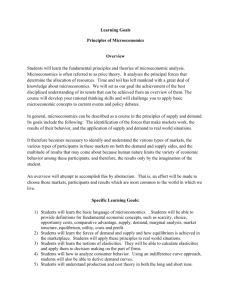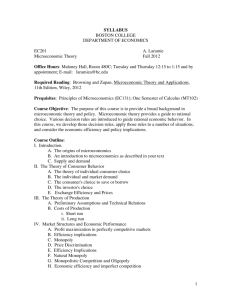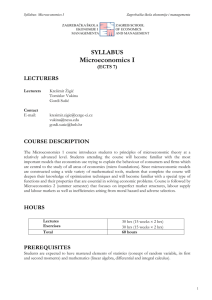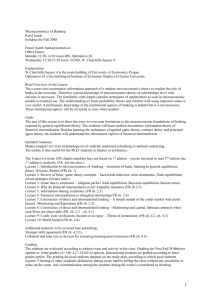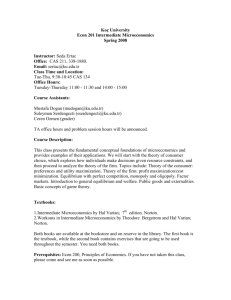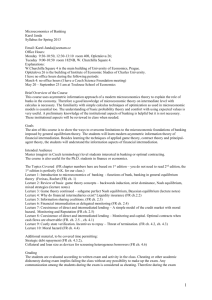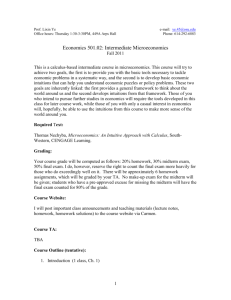Link to Syllabus - Krannert School of Management
advertisement
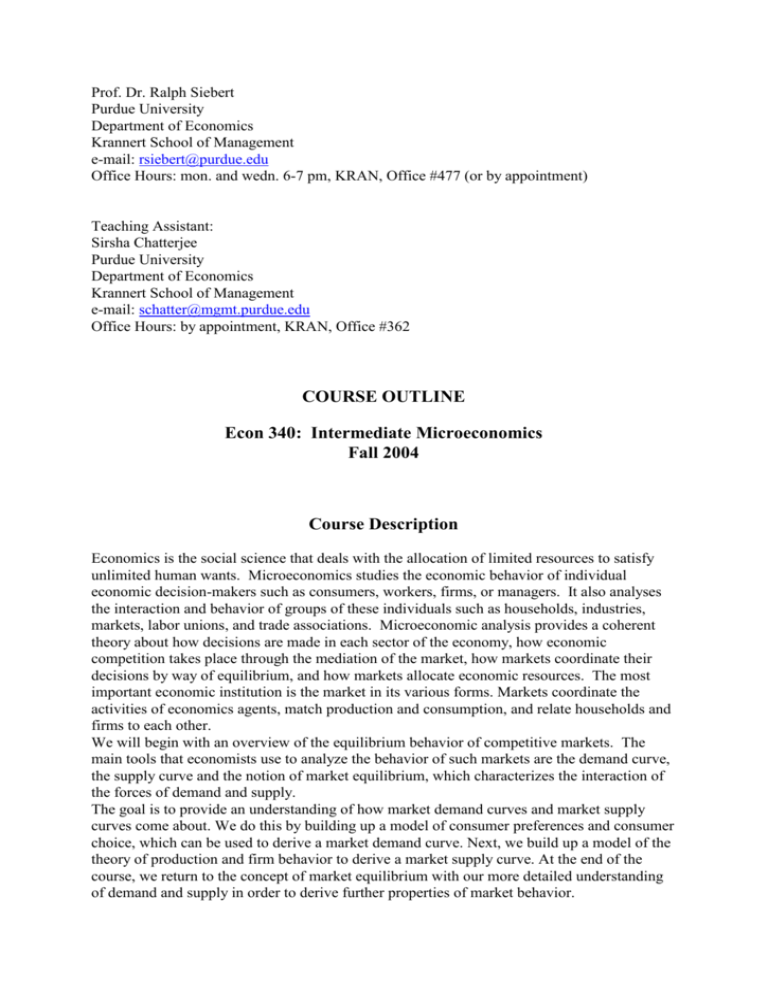
Prof. Dr. Ralph Siebert Purdue University Department of Economics Krannert School of Management e-mail: rsiebert@purdue.edu Office Hours: mon. and wedn. 6-7 pm, KRAN, Office #477 (or by appointment) Teaching Assistant: Sirsha Chatterjee Purdue University Department of Economics Krannert School of Management e-mail: schatter@mgmt.purdue.edu Office Hours: by appointment, KRAN, Office #362 COURSE OUTLINE Econ 340: Intermediate Microeconomics Fall 2004 Course Description Economics is the social science that deals with the allocation of limited resources to satisfy unlimited human wants. Microeconomics studies the economic behavior of individual economic decision-makers such as consumers, workers, firms, or managers. It also analyses the interaction and behavior of groups of these individuals such as households, industries, markets, labor unions, and trade associations. Microeconomic analysis provides a coherent theory about how decisions are made in each sector of the economy, how economic competition takes place through the mediation of the market, how markets coordinate their decisions by way of equilibrium, and how markets allocate economic resources. The most important economic institution is the market in its various forms. Markets coordinate the activities of economics agents, match production and consumption, and relate households and firms to each other. We will begin with an overview of the equilibrium behavior of competitive markets. The main tools that economists use to analyze the behavior of such markets are the demand curve, the supply curve and the notion of market equilibrium, which characterizes the interaction of the forces of demand and supply. The goal is to provide an understanding of how market demand curves and market supply curves come about. We do this by building up a model of consumer preferences and consumer choice, which can be used to derive a market demand curve. Next, we build up a model of the theory of production and firm behavior to derive a market supply curve. At the end of the course, we return to the concept of market equilibrium with our more detailed understanding of demand and supply in order to derive further properties of market behavior. Next, we move beyond competitive industry structures to consider various other commonly observed industry structures such as monopoly and oligopoly. We will observe how industry equilibrium differs from the competitive case for each of these structures. Microeconomic analysis relies on a small set of enormously powerful analytical tools: constrained optimization analysis, equilibrium analysis, and comparative statics analysis. This course attempts to help you master these tools by presenting their graphical, algebraic and logical mechanics as well as by illustrating their use in many different contexts throughout the course. Textbooks The textbook we will be using in this course is: D. Besanko and R. Braeutigam, 2002, Microeconomics: An Integrated Approach, ISBN 0-471-17064-X, John Wiley & Sons, Inc. You will find two copies on reserve in the undergrad library. For further readings, I can recommend the following textbooks: For the ‘priniciples’ level: 1. Mankiw, G., 1997, Priniciples of Microeconomics, ISBN 0030245028. For the ‘intermediate’ level: 1. H. Varian, 1999, Intermediate Microeconomics, Fifth Edition, ISBN 0-393-97370-0, W. W. Norton and Company. 2. W. Nicholson, 2004, Intermediate Microeconomics, , ISBN 0-324-17163-3, SouthWestern, Thomson Learning. 3. M.L. Katz and H.S. Rosen, 1998, Microeconomics, Irwin/McGraw-Hill. For the ‘graduate’ level: 1. A. Mas-Colell and M. D. Whinston and J. Green, 1995, Microeconomic Theory, ISBN 019-510268, Oxford University Press. 2. H. Varian, 1992, Microeconomic Analysis, Third edition, ISBN 0-393-95735-7, Norton & Company, Inc. Course Requirements Students will be evaluated on the basis of 1. seven problem sets: problem set will be posted on the webpage and solutions are provided and discussed in the “Calculation Exercises“ (see below). You are allowed to work on the problem sets with another student (maximum size of a group is 3 students). In every problem set you will find one extra task (“asterisk task”) in order to achieve extra credits. There is a deadline for every problem set that you have to consider. Problem sets submitted after the deadline will be graded with 0 points. 2. 1 midterm exam (9th week, Monday 18th October) 3. final exam (17th week, date will be announced in class and on webpage) Weights for purposes of grading are as follows: 7 PROBLEM SETS 1 MIDTERM EXAM FINAL EXAM 7 x 5%=35% 25% 40% You will also find the solutions to the problems sets, the midterm and the final as well as your grades on Katalyst. Moreover, you will find more exercises and solutions on the following webpage: http://jws-edcv.wiley.com/college/bcs/redesign/student/chapter/0,12264,_047117064X_BKS_1023__27___,00.html Course Reading List Chapter 1: Analyzing Economic Problems (1 session) Chapter 2: Supply and Demand Analysis (2 session) Problem Set #1 Chapter 3: Preferences and Utility (1 session) Chapter 4: Consumer Choice (1 session) Problem Set #2 Chapter 5: The Theory of Demand (2 session) Problem Set #3 Chapter 6: Inputs and Production Functions (1 session) Chapter 7: Costs and Cost Minimization (2 sessions) Problem Set #4 Midterm Exam Chapter 8: Cost Curves (2 session) Chapter 9: Perfectly Competitive Markets (2 sessions) Problem Set #5 Chapter 10: Competitive Markets: Applications (1 session) Chapter 11: Monopoly and Monopsony (2 sessions) Problem Set #6 Chapter 12: Capturing Surplus (2 sessions) Chapter 13: Market Structure and Competition (3 session) Problem Set #7 Chapter 14: Game Theory and Strategic Behavior (1 session) Final Exam Calculation Exercises The following exercises are supposed to help you in understanding the solutions of the problem sets and give you the opportunity to discuss the problem sets. The exercises will be held by Sirsha Chatterjee. Exercise #1: Exercise #2: Exercise #3: Exercise #4: Exercise #5: Exercise #6: Wednesday, Sept., 1st, 2004 Monday, Sept. 20th, 2004 Wednesday, Sept 29th, 2004 Monday, October, 25th, 2004 Monday, November, 8th, 2004 Monday, November, 22nd , 2004
